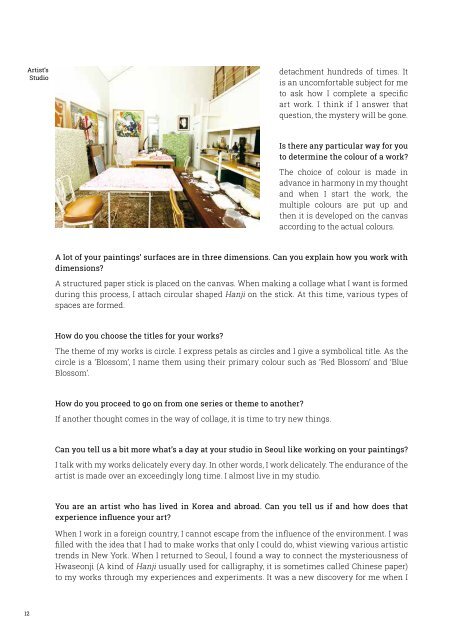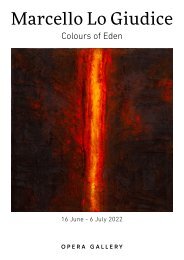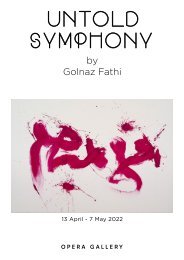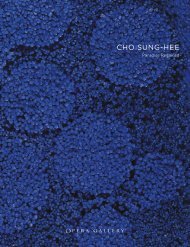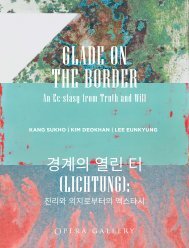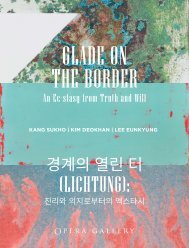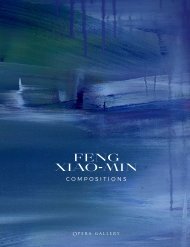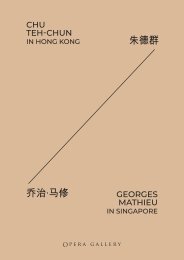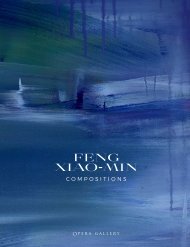Cho Sung-Hee: Splendid Stars
Cho Sung-Hee: Splendid Stars Solo exhibition in London, March 2018
Cho Sung-Hee: Splendid Stars
Solo exhibition in London, March 2018
You also want an ePaper? Increase the reach of your titles
YUMPU automatically turns print PDFs into web optimized ePapers that Google loves.
Artist’s<br />
Studio<br />
detachment hundreds of times. t<br />
is an uncomfortable subect for me<br />
to ask how complete a specific<br />
art work. think if answer that<br />
question, the mystery will be gone.<br />
Is there any particular way for you<br />
to determine the colour of a work?<br />
The choice of colour is made in<br />
advance in harmony in my thought<br />
and when start the work, the<br />
multiple colours are put up and<br />
then it is developed on the canvas<br />
according to the actual colours.<br />
A lot of your paintings’ surfaces are in three dimensions. Can you explain how you work with<br />
dimensions?<br />
A structured paper stick is placed on the canvas. When making a collage what want is formed<br />
during this process, attach circular shaped Hanji on the stick. At this time, various types of<br />
spaces are formed.<br />
How do you choose the titles for your works?<br />
The theme of my works is circle. express petals as circles and give a symbolical title. As the<br />
circle is a ‘lossom’, name them using their primary colour such as ‘ed lossom’ and ‘lue<br />
lossom’.<br />
How do you proceed to go on from one series or theme to another?<br />
f another thought comes in the way of collage, it is time to try new things.<br />
applied the colour to ‘lossom’, the circle which is the theme of my work, using turpentine oil.<br />
When you paint colour on Hanji, the circular shape sinks because Hanji is touched by water and it<br />
is collapsed. However, it was not easy to colour Hanji with oil painting. t is because of the weight<br />
of oil paints. After many experiments, applied oil painting with turpentine and could maintain<br />
the circular shape of Hanji. did not find much transparency when used oil colours, but when <br />
used the method on Hanji, could see the clear colour that Hanji has. At that moment, suddenly<br />
felt the oy from the colour and wanted to spread the ‘Happy irus’. Generally speaking, nobody<br />
thought that Hanji and turpentine would be a good match. ut paper is from tree and turpentine<br />
is also from resin of the tree. Therefore, the fusion of these two made a good match.<br />
Is there any room for accidents – beautiful coincidences in that case – in your working process?<br />
When artists express their ideas ith the work, they do it with accuracy. However, during the<br />
work, sometimes we encounter an unexpected contingency. Since this contingency was not<br />
intended by the artist, do not think it is meaningful. f contingency is established in my works,<br />
it is not from me concretely, or my deep thought. Therefore, an artist never chooses chance<br />
or contingency. However, the artist has a lot of thoughts in the mind while working. While<br />
wandering we meet good changes in the thought. When it happens to me, select the change.<br />
Especially, find many changes in the process of colouring.<br />
What are some other themes you would like to explore in your upcoming works?<br />
The theme of these works is ‘lossom’. want to continue the ‘lossom’ series. also made around<br />
structural wood pieces with the help of a carpenter. Of course, the base material is wood, but<br />
develop them as collage, putting together<br />
partly finished wood pieces and adding<br />
Hanji collage on it. ut am still waiting to<br />
harmonise these. So, it is my task next year<br />
to see how can integrate these sculptural<br />
structures with ‘lossom’ perfectly.<br />
Can you tell us a bit more what’s a day at your studio in Seoul like working on your paintings?<br />
talk with my works delicately every day. n other words, work delicately. The endurance of the<br />
artist is made over an exceedingly long time. almost live in my studio.<br />
You are an artist who has lived in Korea and abroad. Can you tell us if and how does that<br />
experience influence your art?<br />
When work in a foreign country, cannot escape from the influence of the environment. was<br />
filled with the idea that had to make works that only could do, whist viewing various artistic<br />
trends in ew ork. When returned to Seoul, found a way to connect the mysteriousness of<br />
Hwaseoni (A kind of Hanji usually used for calligraphy, it is sometimes called Chinese paper)<br />
to my works through my experiences and experiments. t was a new discovery for me when <br />
Hanji paper<br />
12 13


